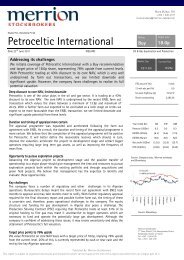Quarterly Bulletin Q3 2013
Quarterly Bulletin Q3 2013
Quarterly Bulletin Q3 2013
Create successful ePaper yourself
Turn your PDF publications into a flip-book with our unique Google optimized e-Paper software.
88<br />
Analysis of Recent Monetary Operations &<br />
<strong>Quarterly</strong> <strong>Bulletin</strong> 03 / July 13<br />
Financial Market Developments<br />
debt instruments issued or guaranteed by the<br />
central government, and credit claims granted<br />
to or guaranteed by the central government,<br />
of countries that are eligible for OMT or are<br />
under an EU-IMF programme. Such countries<br />
must comply with the related conditionality, as<br />
assessed by the Governing Council.<br />
On 12 September 2012, the ECB extended<br />
the liquidity swap arrangement with the Bank<br />
of England up to 30 September <strong>2013</strong>. The<br />
swap facility agreement established on 17<br />
December 2010 had been authorised until the<br />
end of September 2011 and then extended<br />
until 28 September 2012.<br />
On 31 October 2012, the second Covered<br />
Bond Purchase Programme (CBPP2) ended as<br />
scheduled. The purchases of covered bonds<br />
commenced in November 2011. The initially<br />
targeted total nominal amount of purchases<br />
was €40bn, and the purchases were expected<br />
to have been carried out in full by 31 October<br />
2012. As announced at the press conference<br />
of 4 April 2012, the ECB had slowed down<br />
the pace of purchases in response both to<br />
investors’ increasing demand for euro area<br />
covered bonds and the decline in the supply of<br />
covered bonds. Accordingly, a nominal amount<br />
of €16.4bn was purchased on the primary and<br />
secondary markets between November 2011<br />
and October 2012.<br />
On 6 December 2012, the Governing<br />
Council decided to continue conducting its<br />
main refinancing and one maintenance period<br />
operations as fixed rate tender procedures with<br />
full allotment (introduced on 8 October 2008)<br />
for as long as necessary, and at least until 9<br />
July <strong>2013</strong>.<br />
On 13 December 2012, the ECB<br />
announced the extension of the existing<br />
swap arrangements with other central banks.<br />
The Bank of Canada, the Bank of England,<br />
the US Federal Reserve and the Swiss<br />
National Bank announced an extension of<br />
the existing temporary US dollar liquidity<br />
swap arrangements until 1 February 2014.<br />
Previously, these swap arrangements had<br />
been authorised until 1 February <strong>2013</strong>. These<br />
central banks also extended until 1 February<br />
2014 the network of temporary bilateral<br />
liquidity swap arrangements that enable the<br />
provision of liquidity in each jurisdiction in any<br />
of their currencies, should market conditions<br />
so warrant. Previously, these bilateral liquidity<br />
swap arrangements had been authorised until<br />
1 February <strong>2013</strong>.<br />
On 2 May <strong>2013</strong>, the Governing Council<br />
narrowed the interest rate corridor when it<br />
decided to lower the interest rate on the main<br />
refinancing operations of the Eurosystem by<br />
25 basis points to 0.50%. The rate on the<br />
marginal lending facility was reduced by 50<br />
basis points to 1.00% and the rate on the<br />
deposit facility remained unchanged at 0.00%.<br />
In addition, the Governing Council decided<br />
to continue conducting its main refinancing<br />
and one maintenance period operations as<br />
fixed rate tender procedures with full allotment<br />
(introduced on 8 October 2008) for as long as<br />
necessary, and at least until 8 July 2014.<br />
2. Money Market Developments<br />
Euro area money markets improved markedly<br />
over the course of 2012, strongly influenced by<br />
ECB decisions. In the first half of the year, the<br />
liquidity injected by the ECB via the two 3-year<br />
LTROs had a stabilising effect on the money<br />
market and addressed banking refinancing<br />
and funding risks in the short to medium term.<br />
Following this, the ECB rate cut, the reduction<br />
in the deposit facility rate to zero and the<br />
announcement of the OMT programme soon<br />
after, further eased the difficulties of banks<br />
in peripheral countries accessing interbank<br />
funding, although this was predominately<br />
confined to collateralised markets. Higher<br />
excess liquidity 12 in 2012 put downward<br />
pressure on money market rates to some<br />
extent, particularly following the 3-year LTROs<br />
(See Chart 1).<br />
12 Please refer to Annex 1 for a full glossary of terms.




